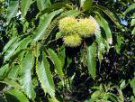Chestnut
  The
genus Castanea (Chestnut) has 7 to 12 species native to Asia,
Europe and North America. In the 20th Century, the
The
genus Castanea (Chestnut) has 7 to 12 species native to Asia,
Europe and North America. In the 20th Century, the  North
American species was decimated by the fungus Endothia parasitica.
All species of Castanea look alike microscopically. American chestnut’s
original (pre-blight) distribution was from Maine west to Michigan
and into the southeast U.S. Most of the trees grew in lower New
England and the Appalachians. American chestnut grew to a height
of 120 ft, with diameters of over 6 feet. The thin sapwood of
American chestnut is off-white, and the heartwood is light brown,
darkening with age. The wood of American chestnut is coarse, medium
in strength, light weight, with medium hardness and shrinkage.
Chestnut works well with most tools for most applications and
is rated as very resistant to decay. It was used for barrel staves,
boxes, caskets, core stock for plywood, crates, fuel wood, furniture,
lumber, mine timbers, poles, pulpwood, railroad ties, shingles,
and tannin extract. North
American species was decimated by the fungus Endothia parasitica.
All species of Castanea look alike microscopically. American chestnut’s
original (pre-blight) distribution was from Maine west to Michigan
and into the southeast U.S. Most of the trees grew in lower New
England and the Appalachians. American chestnut grew to a height
of 120 ft, with diameters of over 6 feet. The thin sapwood of
American chestnut is off-white, and the heartwood is light brown,
darkening with age. The wood of American chestnut is coarse, medium
in strength, light weight, with medium hardness and shrinkage.
Chestnut works well with most tools for most applications and
is rated as very resistant to decay. It was used for barrel staves,
boxes, caskets, core stock for plywood, crates, fuel wood, furniture,
lumber, mine timbers, poles, pulpwood, railroad ties, shingles,
and tannin extract.
http://www.fpl.fs.fed.us/documnts/TechSheets/HardwoodNA/pdf_files/castaneamet.pdf.
Characteristics found in the Chestnut
(Castanea spp.):
- Ring Porous
- Dendritic latewood
- Simple perforations
- I/V pits linear
- Rays Uniseriate
- Crystals in axial parenchyma
- Latewood Vessels thin-walled and angular, like those in
the White Oak Group
WOOD SLIDES
Click on each image to view a larger
image.
   

CHARCOAL SLIDES
   
   
|




 North
American species was decimated by the fungus Endothia parasitica.
All species of Castanea look alike microscopically. American chestnut’s
original (pre-blight) distribution was from Maine west to Michigan
and into the southeast U.S. Most of the trees grew in lower New
England and the Appalachians. American chestnut grew to a height
of 120 ft, with diameters of over 6 feet. The thin sapwood of
American chestnut is off-white, and the heartwood is light brown,
darkening with age. The wood of American chestnut is coarse, medium
in strength, light weight, with medium hardness and shrinkage.
Chestnut works well with most tools for most applications and
is rated as very resistant to decay. It was used for barrel staves,
boxes, caskets, core stock for plywood, crates, fuel wood, furniture,
lumber, mine timbers, poles, pulpwood, railroad ties, shingles,
and tannin extract.
North
American species was decimated by the fungus Endothia parasitica.
All species of Castanea look alike microscopically. American chestnut’s
original (pre-blight) distribution was from Maine west to Michigan
and into the southeast U.S. Most of the trees grew in lower New
England and the Appalachians. American chestnut grew to a height
of 120 ft, with diameters of over 6 feet. The thin sapwood of
American chestnut is off-white, and the heartwood is light brown,
darkening with age. The wood of American chestnut is coarse, medium
in strength, light weight, with medium hardness and shrinkage.
Chestnut works well with most tools for most applications and
is rated as very resistant to decay. It was used for barrel staves,
boxes, caskets, core stock for plywood, crates, fuel wood, furniture,
lumber, mine timbers, poles, pulpwood, railroad ties, shingles,
and tannin extract.











